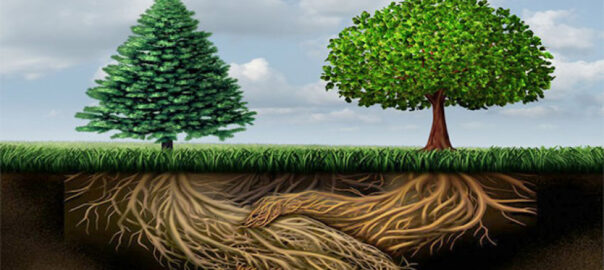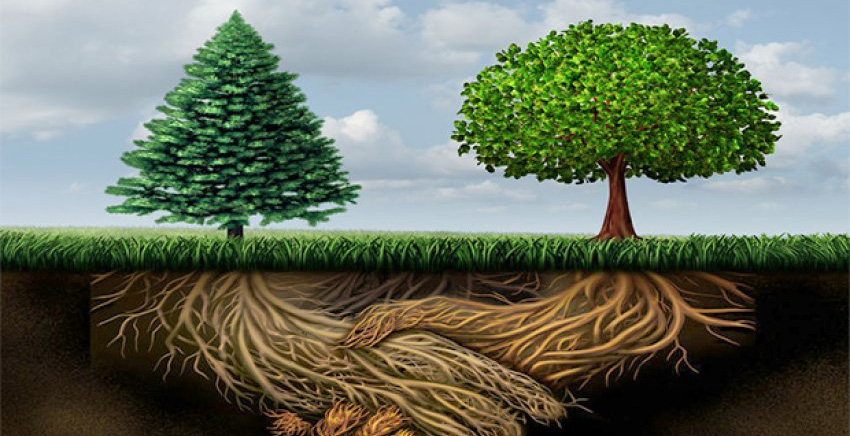
The Origins of Morality
Evidence suggests that human morality is a synthesis of many factors: the biological, the cultural, the unlearned and the invented. It all begins at birth when we come into the world with a moral foundation, a basis of morality, which helps us survive as individuals within a group.
The content of this section, unless indicated, represents Robert Ornstein’s award-winning Psychology of Evolution Trilogy and Multimind. It is reproduced here by kind permission of the Estate of Robert Ornstein.
Before recent studies in animal behavior, developmental psychology, neuroscience and even biology transformed our notion of morality, human beings in all societies thought that morality “cometh to them from above.” In many religions, a divine influence —that gave us the Ten Commandments, the Five Pillars of Islam and the Hindu Purusarthas — is believed to direct and organize humanity’s moral principles. As a consequence, for many thinkers, the human being stands out as “the moral animal.” But taken alone, out of the religious context, that title reveals the same center-of-the-universe mentality as our pre-Copernicus predecessors had when presented with the fact that every planet, including Earth, revolved around the Sun.
Basic morality isn’t even limited to animals. For instance, a paper on “plant kin recognition” notes that plants allocate fewer of their own roots to gather nutrients when surrounded by other plants of the same kind, than they do when surrounded by “strangers.” In 2009, researchers showed that a beach weed called sea rocket senses whether it is growing among siblings or among unrelated plants of the same species. When it detects the presence of “strangers,” it allocates more resources toward sprouting nutrient-grabbing roots than when it recognizes kin.
There are thousands of studies of “moral” and/or empathic awareness in animals. In one experiment, each rat learns to press a lever for food; then another rat is introduced into the next cage, and the lever’s wiring is altered so that when the first rat presses the lever for food, the second rat gets an electric shock. Researchers found that the first rats stopped pressing the lever for a while, forfeiting their chance to get food. However, they eventually returned to pressing the lever, because otherwise they would have starved. But an empathic response to their fellow rats’ distress dictated their initial responses.
A similar experiment was carried out with rhesus monkeys. They learned to pull on a chain to get food delivered into their cage; then another monkey was put into the next cage, and the wiring was altered so that the second monkey got a shock when the first monkey pulled the chain for its food. The upshot was that the first monkeys desisted from pulling the chain and voluntarily starved themselves for between five and 12 days. They were more likely to do this if they were familiar with the second monkey than if the second monkey was a stranger and were also more likely to do it if the second monkey was a rhesus rather than a member of another species. But regardless, they still did desist. Such examples show that some of the core capacities underlying our own morality preceded us into the world and are present in nonhuman animals. Like rats and monkeys, we’re more likely to help those who are like us.
As we mentioned in the Section entitled Bonobos and Chimpanzees: Human Traits in Our Nearest Relatives, connectedness to others involves both reciprocity and empathy — the two pillars upon which morality is built — and both are found in bonobos and other apes.
We are born with a sense of morality
“The moral sense, or conscience, is as much a part of man as his leg or arm. It is given to all human beings in a stronger or weaker degree, as force of members is given them in a greater or less degree.” – Thomas Jefferson
Unsurprisingly then, human infants are born with a nascent moral sense. As developmental psychologist Paul Bloom states in his book Just Babies: The Origins of Good and Evil, “we now understand how the amoral force of natural selection might have instilled within us some of the foundation for moral thought and moral action…. This is not the same as an impulse to do good and avoid doing evil. Rather, it is the capacity to make certain types of judgments – to distinguish between good and bad, kindness and cruelty.” In other words, as a consequence of our biological evolution, humans come into the world with the moral underpinnings that help ensure our survival as individuals who co-habit with others.
From his observations in 1872 recorded in The Descent of Man, Charles Darwin realized that “If the one tribe included … courageous, sympathetic and faithful members who were always ready to warn each other of danger, to aid and defend each other, this tribe would without doubt succeed best and conquer the other.”
Our morality compass: Who’s like me?
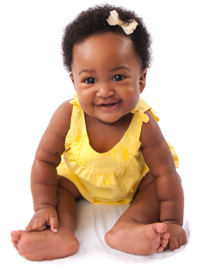
We come into the world with a moral foundation, a basis of morality, which helps us survive as individuals within a group. So our first priority is to know what group that is and who’s in it. Babies constantly have to distinguish between “Us” and “Them” and are primed to prefer “Us.” Newborns make distinctions between familiar and strange people almost immediately. Babies learn to use the rate at which they suck on a pacifier to control which voice they hear read a story: their mother’s or a stranger’s; and at less than three days old infants show a uniform preference for their mother’s voice. As babies develop, they quite naturally base their preferences, their adaptive biases, on the people around them: their own group.
It seems that we are born with the ability to judge who is “like me” and who isn’t: not in appearance, but in mind. Babies as young as seven months old prefer people who are like-minded – who, for example, might prefer Cheerios to Graham Crackers as they do – and they dislike those whose opinions differ. More than 80% of babies under a year old, and 100% of those a little over a year old continue to prefer like-minded individuals even when they appear to harm others who are not like them! It obviously had to be a priority for us to distinguish and prefer our own group from the start, and to be wary of outsiders.
Babies prefer to hear the language that is the most familiar to them, and young children tend to prefer a playmate who speaks their own language, which makes sense, since it is so much easier; but strangely there is also a bias not only towards the same language, but towards the same accent. Language and accent preferences override race: a white child will tend to choose a black child with the same accent over a white child with a different accent.
Four capacities tied to morality
The overwhelming majority of babies tested recognize and show preference for nice actions over mean actions. According to psychologist Paul Bloom our natural moral endowments include four capacities:
1. A moral sense – some capacity to distinguish between kind and cruel actions.
As we already mentioned, kindness to kin has been noted in many species of the animal world, and even in the plant world, because it quite obviously ensures the survival of parental and family genes: we take care of our own first. But even in rats and certainly in our primate ancestors, acts of kindness have been seen to include others outside the immediate group, and even towards another species.
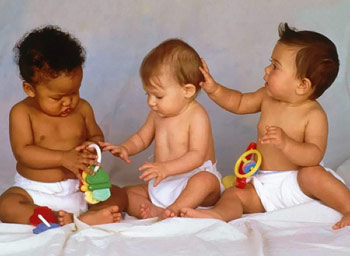
Unsurprisingly, infants’ sensitivity to “badness” is more powerful and emerges earlier than their sensitivity to “goodness.” It pays to be warned about a potential threat. Karen Wynn, director of the Yale Infant Cognition Center, also known as the Baby Lab, has run repeated experiments with 3- and 5-month-old children and established that the overwhelming majority of them – more than three-fourths of babies tested – recognize and show preference for nice actions over mean actions, leading them to prefer nice individuals over mean individuals. Just about all the 6- and 10-month-old infants prefer the helpful individual to the hindering individual. “Study after study after study, the results are always consistently showing babies feeling positively towards helpful individuals in the world. And disapproving, disliking, maybe condemning individuals who are antisocial towards others,” she says.
Infants at the Yale Baby Lab are given a puppet show featuring a gray cat who attempts to open a big box but can’t. Along comes a bunny in a green T-shirt who helps kitty get into the box. The same scene is repeated only this time a bunny wearing an orange T-shirt rudely slams the box shut.
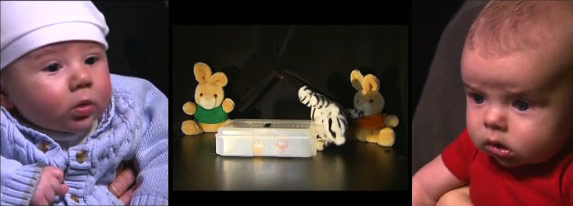
The conclusion: Green bunny is good. Orange bunny is bad. Then a staff member, who doesn’t know which bunny is good or bad, will present the bunnies to the baby. In over 80% of the responses, babies pick the good bunny. Surprisingly, in three-month olds the positive response bumps up to 87%.
Human babies are born with innate indiscriminate cooperative and helpful tendencies that can form the basis of a morality is they grow. As early as six months old, children begin to help spontaneously, and the degree that they do so goes up in the following years, but with friends and family, rarely with total strangers. A toddler of one or two years old will help a relative stranger open a door, for example, and do so without encouragement or praise – though it’s unlikely that he will do so for a complete stranger before the age of 4.
As early as six months old, children begin to help spontaneously.
Three-year-olds are more likely to help someone whom they have seen help others, and less likely to help someone who has been unkind to another person. They really are motivated by genuine care since they actually get involved in accomplishing the goals of the person they help, and act with that person’s interests in mind, not their own. For example, if asked to pass a cup so that someone can pour water in it, they will make sure that the cup is not damaged, even though it was previously selected by the experimenter.
2. A rudimentary sense of fairness – a tendency to favor equal divisions of resources
At fifteen months old, a child will look longer at an unfair division, suggesting that he/she found it surprising. (A control study ruled out the possibility that they just look longer at asymmetric displays.) By sixteen months, babies prefer a puppet who is seen to act fairly by dividing resources equally between two other puppets; at nineteen months old, when two toddlers clean up a room, they expect equal reward even if the effort was unequal. But, between six and eight years old, children amend their view of equal division if told that one person did more than another. Six- to eight- year-olds prefer to throw out an extra item rather than have one person get more than another, unless, again, the circumstances are explained and there is a justification for giving more to that person. If there is an odd number of resources and they don’t have the option of throwing one away, even three-year-olds will prefer to give more to siblings and friends than to strangers; or give the extra one to someone who they have previously seen act generously to a third person.

Although they are sensitive to inequality, children of five or six are just like our simian relatives – they get upset about it only when they are the ones getting less. In fact, they would rather get nothing than have another child, a stranger, get more than they do; and half of the young children tested of this age chose not to give away candy to strangers even if it costs them nothing. Interestingly, young children focus primarily on social comparison and routinely choose to get less for themselves from a number of options offered if this means getting more than the other party. However, once children are seven or eight years old, about 80% of them will give candy to someone they don’t know; by around 8 years old children tend to act fairly; and by 9 or 10 – by which time they have been acculturated and educated – they may deliberately give the other person more than they take themselves.
3. A rudimentary sense of justice – a desire to see good actions rewarded and bad actions punished
A number of studies indicate that babies not only have a sense of fairness but also a strong belief in punitive action when it’s deserved. For example, a bunny puppet steals a ball and runs away. But in the next scene this same bunny tries to open a box to get a toy, but another bunny slams the box shut and prevents him from doing so. 81% of babies preferred the bunny who “punished” the ball thief. “What we’re finding in the baby lab, is … that there’s a universal moral core that all humans share. The seeds of our understanding of justice, our understanding of right and wrong, are part of our biological nature,” says Paul Bloom. By eight months old, babies preferred a puppet who was mean to a “bad” puppet over the one who was nice to it.
…females tend to respond empathetically regardless of how they have been treated.
Bloom’s explorations led him to conclude that “We have evolved a tendency to retaliate against those who harm us and who harm the people we love because by doing so we deter such behavior in the future.” Because we empathize with others, we extend these sentiments to our larger community. Third-party punishment appears to be revenge plus empathy: “what would I want if I were the victim?” There appears to be an intimate connection between judging others and judging ourselves. We feel more guilt if we harm someone with whom we empathize and our empathy is biased towards those whom we perceive in a positive light. If someone treats us or our group badly, we will have no, or much less, empathy for him, particularly if we are male. It turns out that females tend to respond empathetically regardless of how they have been treated.
4. Empathy and compassion – suffering at the pain of those around us and the wish to make this pain go away
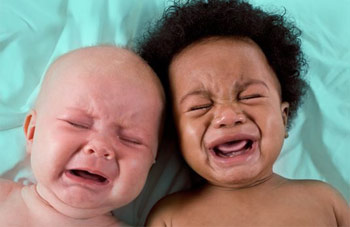
Babies will cry at the sound of another baby crying and can identify the difference between this and a computer-generated noise at the same volume or the cry of another species: say a chimpanzee. Animals, such as rats or monkeys, react to others of their species expressing distress and psychologists suggest that we all may have evolved to find another’s distress unpleasant – even sometimes overwhelming. This is described as “emotional contagion” and may indicate a basic feeling of empathy but does not mean that we feel compassion. We don’t necessarily care about a person but we still can empathize: we can put ourselves in that person’s shoes.
Even in the first year of life, babies show distress if they harm someone; and one- or two-year-old babies – particularly girls – will try to sooth someone in pain and to comfort someone in distress. Similar behavior in other primates has been noted by Frans de Waal and others. Additionally, Bloom suggests, over time altruism and morality evolved because cooperative individuals were rewarded while those that go against the community were punished or avoided – and were less likely to reproduce.
As mentioned, babies are aware of good and bad acts long before they are capable of acting themselves and it seems that we gradually develop a moral sense of self, which is manifested in guilt, shame and pride. Bloom quotes an experiment conducted by the psychologist Charlotte Buhler back in 1935, which demonstrated that one- and two-year-olds don’t immediately understand that a rule set by an adult applies once the adult leaves their sight. An adult and child were in a room together and the adult forbade the child to touch a toy, easily within reach. Once the adult leaves the room the child immediately plays with the toy. But when the adult suddenly returns, 60 percent of the sixteen-month-olds and 100 percent of the eighteen-month-olds “show the greatest embarrassment, blush, and turn to the adult with a frightened expression,” indicating that they do self-evaluate; and, in this instance, experienced some form of guilt or shame.
“Morality, then, is a synthesis of the biological and the cultural, of the unlearned, the discovered and the invented. Babies possess certain moral foundations — the capacity and willingness to judge the actions of others, some sense of justice, gut responses to altruism and nastiness. Regardless of how smart we are, if we didn’t start with this basic apparatus, we would be nothing more than amoral agents, ruthlessly driven to pursue our self-interest. But our capacities as babies are sharply limited. It is the insights of rational individuals that make a truly universal and unselfish morality something that our species can aspire to.” Paul Bloom, “The Moral Life of Babies“, New York Times Magazine.
In the series: Morality’s Long Evolution
Related articles:
- An Ancient Brain in a Modern World
- Our Unconscious Minds
- Connecting with Others
- Morality’s Long Evolution
- Unconscious Associations
- The Brain’s Latent Capacities
- God 4.0
- Multimind: A New Way of Looking at Human Behavior
- Thinking Big
- Social
- The Righteous Mind
- New World New Mind
- Moral Tribes
- The Mountain People
- The Matter with Things
- Humanity on a Tightrope
- Beyond Culture

